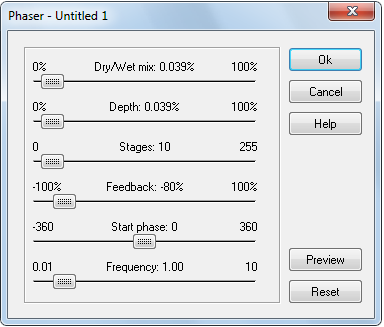A phaser is a sound effect used to filter a signal by creating a series of peaks and troughs in the frequency spectrum. The position of the peaks and troughs is typically modulated so that they vary over time, creating a sweeping effect. For this purpose, phasers usually include a low-frequency oscillator.
Structure
The Phaser uses a series of variable all-pass phase-shift networks, which alter the phases of the different frequency components in the signal. These networks pass all frequencies at equal volume, introducing only phase change to the signal. Human ears are not very responsive to phase differences, but this creates audible interferences when mixed back with the dry (unprocessed) signal, creating notches. The simplified structure of a mono phaser is shown below:

The number of all-pass filters (usually called stages) varies with different models. This determines the number of notches/peaks in the sound, affecting the general sound character. A phaser with n stages generally has n/2 notches in the spectrum, so a 4-stage phaser will have two notches.
The output is fed back to the input for a more intense effect, creating a resonant effect by emphasizing frequencies between notches. This involves feeding the output of the all-pass filter chain back to the input.

Phaser Controls
Dry/Wet mix
Sets the ratio of wet (processed) signal to dry (unprocessed) signal of the Phaser structure
Depth
Sets the percentage by which the delay time is modulated in hundredths of a percentage point in the Phaser structure.
Stages
Sets Phaser stages. Recomended from 2 to 24.
Feedback
Sets the percentage of output signal to feed back into the effect's input in the Phaser structure.
Start Phase
Sets Phaser's LFO Startphase in Radians. Needed for stereo Phasers.
Frequency
Sets the frequency of the LFO in the Phaser structure
|
Copyright (c) 2013 AudioDope team. All rights reserved.
|
|
What do you think about this topic? Send feedback!
|